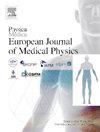Estimating the number of ≥100 mSv patients from CT, fluoroscopic guided interventions, and PET exams in 27 OECD countries
IF 3.3
3区 医学
Q1 RADIOLOGY, NUCLEAR MEDICINE & MEDICAL IMAGING
Physica Medica-European Journal of Medical Physics
Pub Date : 2025-05-21
DOI:10.1016/j.ejmp.2025.105006
引用次数: 0
Abstract
Purpose
To estimate the number of patients in 27 OECD (Organization for Economic Co-operation and Development) countries receiving a cumulative effective dose (CED) ≥100 mSv from recurrent imaging in computed tomography (CT), fluoroscopic guided intervention (FGI), and positron emission tomography (PET) examinations.
Methods
CT and PET utilization and population data for 27 OECD countries were retrieved from a publicly available OECD 2022 report, and FGI utilization data from the European Commission 2015 Report. Data on the number of exams per patient of each modality and the prevalences of ≥100 mSv patients were extracted via a literature review and used to estimate the total number of imaging patients and ≥100 mSv patients in each country.
Results
An estimated 1.36 million patients (0.27 %) received a dose ≥100 mSv among the 513 million residents of the 27 countries. One-third of the countries have more than 3 patients/1,000 population with ≥100 mSv dose in a 5-year period ranging from 1.09 (Finland) to 4.52 (Belgium). A linear trend between the number of ≥100 mSv patients and the total number of CTs in a country was observed, and this can be used for extrapolation at the regional or global level.
Conclusion
This is the first study estimating the number of patients who may have received CED ≥100 mSv through recurrent multimodality (CT, FGI, and PET) exams. With the number of such patients being large, a call for attention is needed from relevant national and international organizations.
估计27个经合组织国家CT、透视引导干预和PET检查中≥100 mSv患者的数量
目的估计27个OECD(经济合作与发展组织)国家在计算机断层扫描(CT)、透视引导干预(FGI)和正电子发射断层扫描(PET)检查中接受累积有效剂量(CED)≥100 mSv的患者人数。方法从公开的OECD 2022年报告中检索27个OECD国家的sct和PET利用和人口数据,从欧盟委员会2015年报告中检索FGI利用数据。通过文献综述提取了每种模式的每位患者的检查次数和≥100毫西弗患者的患病率数据,并用于估计每个国家影像学患者和≥100毫西弗患者的总数。结果在27个国家的5.13亿居民中,估计有136万患者(0.27%)接受了≥100 mSv的剂量。三分之一的国家在5年期间每1000人中有3名以上患者剂量≥100毫西沃特,从1.09(芬兰)到4.52(比利时)不等。观察到一个国家≥100毫西弗患者数量与ct总数之间存在线性趋势,这可用于区域或全球水平的外推。这是第一个通过复发性多模态(CT、FGI和PET)检查估计可能接受CED≥100 mSv的患者数量的研究。由于这类患者人数众多,需要引起相关国家和国际组织的关注。
本文章由计算机程序翻译,如有差异,请以英文原文为准。
求助全文
约1分钟内获得全文
求助全文
来源期刊
CiteScore
6.80
自引率
14.70%
发文量
493
审稿时长
78 days
期刊介绍:
Physica Medica, European Journal of Medical Physics, publishing with Elsevier from 2007, provides an international forum for research and reviews on the following main topics:
Medical Imaging
Radiation Therapy
Radiation Protection
Measuring Systems and Signal Processing
Education and training in Medical Physics
Professional issues in Medical Physics.

 求助内容:
求助内容: 应助结果提醒方式:
应助结果提醒方式:


